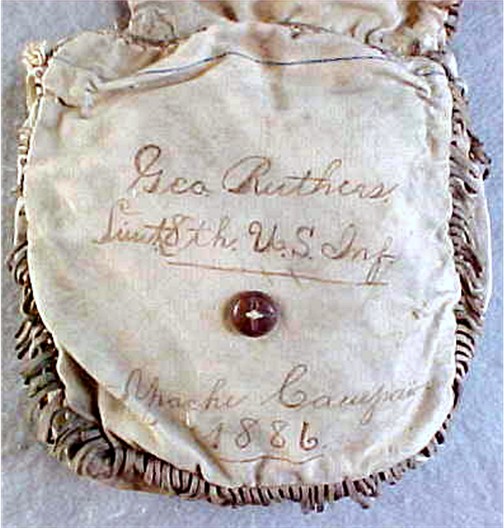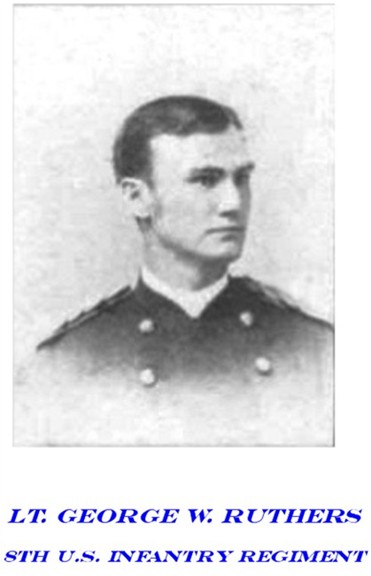|
APACHE WARS OFFICER’S CAMPAIGN POUCH - IDENTIFIED
TO LT. GEORGE WORTHINGTON RUTHERS, 8TH US
INFANTRY REGIMENT, 1886 – A RARE INDIAN WARS ERA
HISTORICAL ARTIFACT: Recently discovered in an
old Texas collection, this campaign pouch is inscribed
on the front panel as the property of Lt. George
Ruthers, 8TH US Infantry Regiment with the
notation “APACHE CAMPAIGN 1886”.

This pouch is fashioned from the same “drab duck”
material the army used to manufacture haversacks and
saddle bag liners during the 1870’s and 1880’s, and it
is very likely the material used in this pouch was
salvaged from one of those articles. Measuring 9” high,
8” wide and 2 ˝” thick, the maker of this pouch was
strongly influenced by the pouches carried by
frontiersmen and Native Americans, as the edge of the
covering flap and the seams that join the gusset to the
front and rear panels of the pouch are decorated with
native tanned buckskin fringe. It is very possible that
this pouch was, in fact, made by an Apache and Lt.
Ruthers seized it from a hostile, from a captured
village, or found it abandoned on the trail while on
campaign. Such an acquisition would explain why the
lieutenant wrote the inscription on the face of the
pouch.
The combination of army materiel and native tanned
leather is not as unusual as one might think. Equipment
such as haversacks and saddle bag liners were considered
expendable items on the company inventories, expected to
be used to destruction on campaign and additional
quantities were maintained as replacements in store at
the frontier posts. While the army may have declared
used equipment no longer serviceable, as those items
were stricken from the inventory what was salvageable
was gleaned from the trash pits by soldiers, civilians
and Indians alike. Even scraps of base materials such
as clothing, metal, harness leather and the duck from
which this pouch is made were scarce commodities on the
frontier and very little was allowed to go to waste.
The maker of this pouch, whether it was Lt. Ruthers, one
of his soldiers, or an Apache, availed themselves of an
opportunity and created a very utilitarian
accoutrement.

George Worthington Ruthers was born on November 22, 1858
in Charleston, (West) Virginia. Little is known of his
early years until he enlisted in the U.S. Army in
Washington D.C. on April 24, 1880 as a Private, in
Company F, 16TH United States Infantry
Regiment. He was promoted to Corporal, serving at that
rank until he was honorably discharged to accept an
appointment as a 2ND Lieutenant, 8TH
Infantry Regiment dated August 4, 1884. The reasons or
events which led to Ruthers’ being offered a commission
are lost to history. It is notable that while his
obituary reported he had received an appointment to the
United States Military Academy, the archives at West
Point have no record that Ruthers ever entered or
attended the academy, must less graduated and was
subsequently commissioned.
Lt. Ruthers traveled to California to join his new
regiment, and then onto Arizona Territory (AT), where he
arrived at Camp San Carlos on April 27, 1886. At some
point over the next month, Ruthers was posted to Ft.
Thomas, AT., where from May 31ST to June 4TH,
he was ordered from the fort in command of a detachment
of soldiers, packers, and Indian scouts in pursuit of a
“band of hostile Indians” then operating in the
immediate area. Upon his return to Ft. Thomas, Ruthers
submitted a hand written detailed after-action report
which survives today in its original form and a copy of
that report is included in this offering. It is of
special note that Ruthers submitted his report to the
commander of the Fort – Major Anson Mills, not the last
famous personality with which the young lieutenant would
interact.
In addition to the details provided in this four page
report being of interest to any student of the Apache
Wars and the pursuit of Geronimo, the report also
provides two key elements associated with this pouch.
First, it establishes that Ruthers was in the field
operating against the hostile Apaches in 1886, the same
date inscribed on the pouch. And second, the
handwritten report provides ample comparisons of
Ruthers’ handwriting to compare to the writing on the
pouch, and from all appearances, the writing on the
report and the writing on the pouch were written by the
same hand, that of Lt. Ruthers.
In November of 1886, with the close of the Geronimo
Campaign, the 8TH Infantry was transferred to
the Department of the Platte and Company F was assigned
to Ft. Niobrara in Nebraska. Having been in the AT for
less than seven months, Ruthers quite likely acquired
this pouch during the week long operation against the
Apaches which he described in his report.
Ruthers remained in the army, transferring between
assignments as an infantry officer and the Commissary
Subsistence Department, serving during the Spanish
American War, and in the Philippines during the
insurrection. Upon his own application, Major Ruthers,
Commissary of Subsistence, retired from active duty
service on March 10, 1912, after more than thirty-one
years of service. While retired, Maj. Ruthers performed
recruiting duties in the Boston, Massachusetts area in
1912 and 1913. He died on April 27, 1918 at
Parkersburg, West Virginia, at 56 years of age, and was
interred at the Arlington National Cemetery.
The pouch is in very good condition, but does show signs
of use. The material is solid with no weak points,
tears or rot, and all of the seams are intact. The
handwritten inked inscription is fully legible, though
faded to the typical brown color of old ink. The fringe
is stiff with age, typical of native tanned buckskin
that has aged and been exposed to the elements, and it
is worn at some points along the edge of the flap.
There is a bridle leather strap sewn across the top of
the rear panel which served as a spreader to maintain
the shape of the top of the bag when it was carrying a
load and also reinforced the points of attachment for
the leather shoulder strap. Only the butts of the
shoulder strap which were sewn to the bag remain, the
strap long gone. A split native tanned buckskin loop
secured the flap to a commercial wooden button sewn to
the front panel. The buckskin loop is hardened and
broke off at some point, but either through fortune or
forward thinking by a previous owner, the loop was kept
with the pouch and was found inside. This could be
repaired or replaced, or left as is, by the new owner
depending on his choice. The duck material is generally
clean, but does show some soiling on the rear panel
consistent with being carried in the field against the
owner’s body.
Included with the sale of
this pouch is an in depth body of biographical research
that has been assembled in a binder, which includes:
* A copy of Ruthers’
photographic portrait taken shortly after being
commissioned.
* A detailed biography of
Ruthers’ life
* A record of Ruthers’
military service
* A full facsimile copy of
Ruthers’ report written on June 6, 1886 at Ft.
Thomas, including a copy of the hand drawn map of the
area he had traversed which he submitted with the report
* A synopsis of the history of
the 8TH Infantry Regiment during the time of
Ruthers’ assignment
* Copies of numerous newspaper
articles reflecting Ruthers’ assignments, transfers,
marriages, the death of his first wife, his divorces
from wives 2 and 3, and his obituary
* A photograph of Ruthers’
tombstone at Arlington National Cemetery
While the standard array of accoutrements issued to the
soldiers during the Indian War survive today in
relatively substantial numbers, unique pieces such as
this pouch – particularly those which are identified to
a specific soldier or campaign - are quite rare. This
pouch could very easily have been used to destruction or
fallen victim to poor storage, and that it survived with
the inscription intact is quite remarkable. Combining
the desirable features of being one of a kind,
identified to an officer serving on the frontier, being
specifically linked to a famous campaign against the
Apaches, and exhibiting the trans-cultural influences in
its manufacture, this pouch will be an excellent
addition to any serious Indian Wars collection.
SOLD
|

